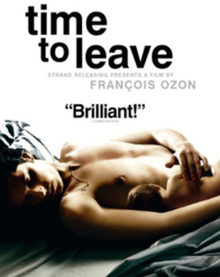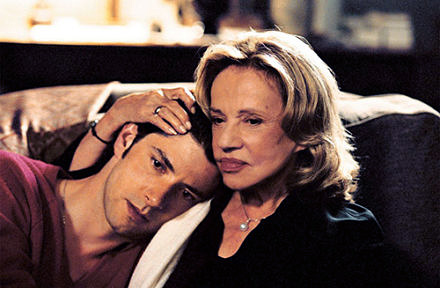 Time to Leave
Time to Leave
le temps qui reste
Written and Directed by François Ozon
Premiered May 16, 2005, at the Cannes Film Festival
Drama (foreign)
81 min.
Review by Stephen O. Murray
November 17, 2009.
I liked gay French director François Ozon’s Eight Women (2002)—with great French actresses from Danielle Darrieux on down in age—a lot, but I was not enamored by Under the Sand (2002) and Swimming Pool (2003), even with Charlotte Rampling, and I out-and-out hated Water Drops On Burning Rocks (1999) and See the Sea (1997). Despite positive reviews about Ozon’s 2005 Le Temps Qui Reste (Time to Leave), it did not seem imperative for me to see it, especially knowing that it portrayed a terminally ill young gay man. (Not AIDS, which was his first question when his physician said he had “bad news” but metastizied cancer.)
It worked its way up my Netflix queue and was better than I expected. The movie is not mawkish or sentimental. Indeed, as 31-year-old fashion photographer Romain (Melvil Poupaud, Le Divorce, A Christmas Tale) says, he is not a nice person. Before he knows he is terminally ill and is nasty to his underlings on a rooftop fashion shoot. Having learned that there is less than a 5% chance of chemotherapy succeeding, he rejects it. He does not want sympathy or support or even witnesses to his dying, and he becomes nothing short of beastly to his older sister Sophie [Louise-Anne Hippeau] with whom, as flashbacks show, he was very close as a child. He also drives off his devoted lover Sasha [Christian Sengewald]. And he repeatedly says he does not like children.
The one person with whom he discusses his condition is his grandmother, a very old-looking Jeanne Moreau [1928–2017]). When she asks “Why tell me?,” he replies that, like him, she is close to death. Whew!
 Romain is plenty attractive and gets both run-of-the mill and out-of-the-ordinary offers from female strangers. Given that we know from the outset that he is going to die soon, I will not give away more information about these offers or his responses to them.
Romain is plenty attractive and gets both run-of-the mill and out-of-the-ordinary offers from female strangers. Given that we know from the outset that he is going to die soon, I will not give away more information about these offers or his responses to them.
Although I wonder about someone with tumors in multiple sites not having wracking pain and being able to go swimming in the ocean, Poupaud gets gaunt (a French Christian Bale in this commitment to a role). He also must have stayed out of the sun except for the Normandy beach scene, since he is not normally so pale. In addition to looking the part of a dying young man, he acts. So often, supposedly very sick and dying people look robust on screen (for instance, Nicole Kidman belting out the big final number before dying of tuberculosis in Moulin Rouge), so it is fair to focus on the physical transformation.
Even if one interprets Romain’s cutting himself off as aimed at not putting others through the agony of providing sympathy and support in advance of his early death, it is difficult not to think that the pain he is sparing those close to him during the process will be followed by greater pain once he is dead and they know they were cut out. Indeed, he knows this but says he will not be around to have to see it. He does not want pity or comfort (he takes a bit of the latter from his grandmother).
 Although not the nobility of standard Hollywood/Life Channel fare, there is nobility to Romain’s decision to die alone and not comfort surviving loved ones. Like his father (Daniel Duval, Caché), it seems Romain has never learned to talk about his feelings.
Although not the nobility of standard Hollywood/Life Channel fare, there is nobility to Romain’s decision to die alone and not comfort surviving loved ones. Like his father (Daniel Duval, Caché), it seems Romain has never learned to talk about his feelings.
The film looks good (having a photogenic protagonist helps, especially one who is in every scene, but Ozon’s usual cinematographer Jeanne Lapoirie (Wild Reeds) again showed her great skill).
The DVD includes 18 minutes of deleted scenes, a 78-minute making-of feature (the movie runs 85) including more graphic sex-club footage, trailers for the movie and four other Strand DVDs.
There is nudity, a three way, and lots of smoking.
© 17 November 2009, Stephen O. Murray

